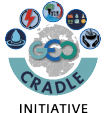In the past 3 years, GEO-CRADLE has been coordinating a multitude of different EO-related activities across the Balkans, Middle East and North Africa regions. This included multiple regional workshops, several analytical studies (e.g. gap analysis, maturity indicators, priorities against regional challenges, etc.) and a set of well-targeted efforts to address specific issues in the region (establishment of Regional Data Hub and networking platform, execution of feasibility studies). Thanks to all these activities, the partners of GEO-CRADLE had the unique opportunity to interact with many EO actors across the whole value chain and over the entire region. The wealth of information collected in this process, brings us today to a position in which we can more securely attempt to answer some key questions:
Where are we now? What is the current state-of-play with regards to EO activities in the NAMEBA region? What challenges is the region still facing? What is the footprint of GEO, GEOSS, Copernicus and other international activities?
Where do we want to be? What is the future we are trying to shape and what is the role of EO in it? Where do we want to direct investment to?
How can we get there? Which actions shall we undertake as an EO community to support informed decision making in this region? Which collaborative activities shall we carry out to achieve the desired future we envisage?
Providing well-justified answers to these questions is the purpose of this roadmap. In that regard, we are attempting to envisage a future for EO activities in the NAMEBA region that whilst being ambitious is also realistic. Its primary focus is on the future implementation/uptake of GEO/GEOSS and Copernicus in the NAMEBA region. In that context, our aim and hope is that the final output of this effort will be truly actionable, i.e. enabling the involved actors to take meaningful action towards maximising the benefits of EO in the region. To that end, we have adopted a rather direct approach defining in very clear terms who should be involved, what should they focus on, how shall they go about implementing these actions and in which timeframes (when). These elements are combined in the form of an action plan that should be considered a “living” document. It is structured so that the different actions fall under five main categories: (i) Infrastructure and data exploitation, (ii) EO in support to policy implementation and decision-making, (iii) Ecosystem Capacity Building, (iv) EO Services Sustainability and (v) Uptake. For each of these categories we have taken into account potential “low-hanging fruit” or “quick wins” vs. longer-term perspectives.
All in all, we hope that this roadmap will pave the way for informed follow-up activities which will further promote multi-actor, cross-border and interdisciplinary collaboration among EO stakeholders in the NAMEBA region, and help deliver EO-based benefits to society and economy.
The full Roadmap is available here.
